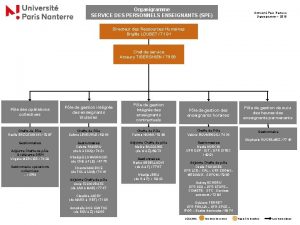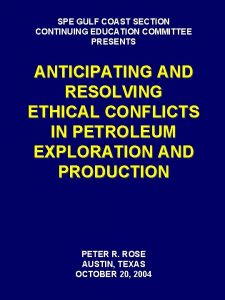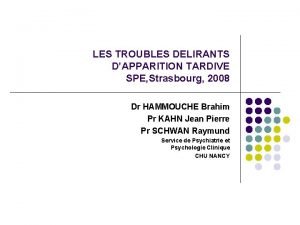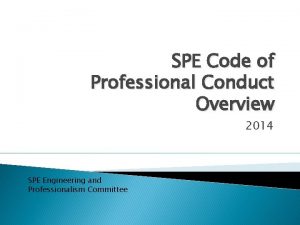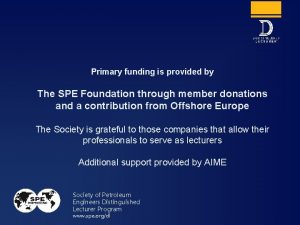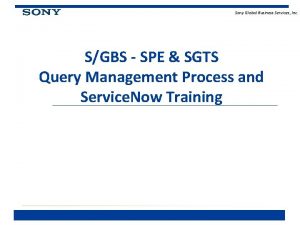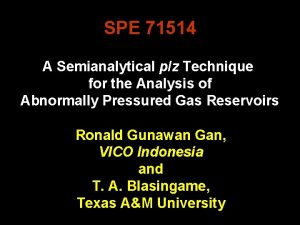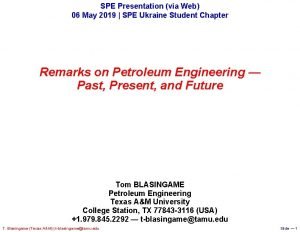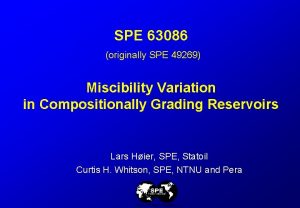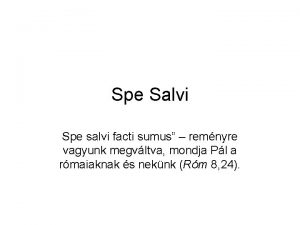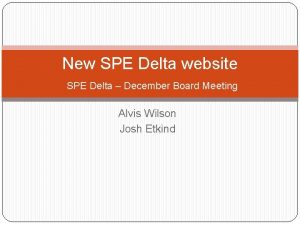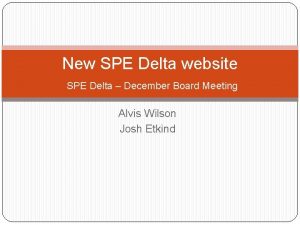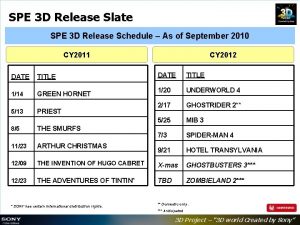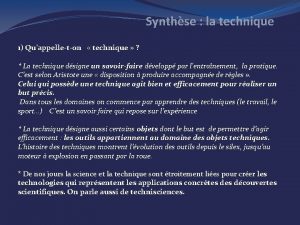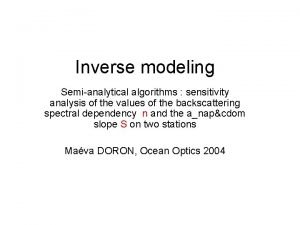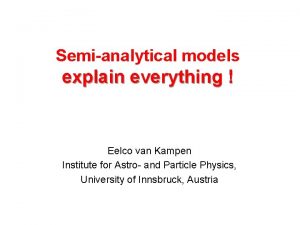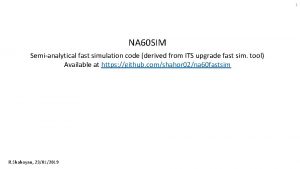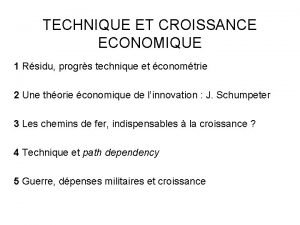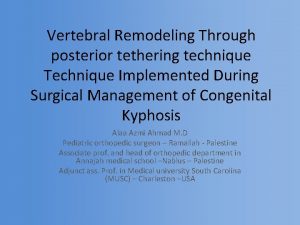SPE 71514 A Semianalytical pz Technique for the


































- Slides: 34

SPE 71514 A Semianalytical p/z Technique for the Analysis of Abnormally Pressured Gas Reservoirs Ronald Gunawan Gan, VICO Indonesia and T. A. Blasingame, Texas A&M University

Objective To present a new technique that can be used to : · Calculate gas-in-place for an abnormally pressured gas reservoir using only average reservoir pressure and cumulative production data. · Calculate pore volume compressibility as a function of reservoir pressure.

Presentation Outline · Introduction · Overview of Existing Methods · New Method · Field Examples · Conclusions

Introduction l p/z schematic for a normally-pressured volumetric gas reservoir p/z Gp G

Introduction p/z schematic for an abnormallypressured gas reservoir l p/z Gp G Gapp

Introduction · Reasons for the non-linear p/z behavior: n Rock and water compressibility effects — "rock collapse theory" (Hawkins, 1969) n Shale water influx (Bourgoyne, 1989)

Existing Methods · Methods based on presumed knowledge of system compressibility: n Hammerlindl (Constant Compressibility), 1971 n Ramagost & Farshad (Constant Comp. ), 1981 n Yale et al. (Variable Compressibility), 1993

· Methods based on presumed knowledge of system compressibility (continued) n Fetkovich, Reese, and Whitson - 1991 - Derived General Material Balance Eq. - Define cumulative effective compressibility, - ce represents the cumulative change in hydrocarbon PV caused by compressibility effects (and water influx).

· Methods which do not require a prior knowledge of system compressibility n Roach - 1981 - very sensitive to initial pressure. - method sometimes doesn’t exhibit a negative intercept (which is not possible). n Bernard - 1985 - using Least Squares approach. - very sensitive to data scatter. n Ambastha - 1991: Type Curve Approach - non-uniqueness problems.

New Method · Satisfies both "rock collapse" and "shale water influx" theories · Develops 2 new plotting functions: 1. 2. · Requires production data only (p and Gp)

New Method · Uses general material balance equation (proposed by Fetkovich, et al. ) · Rearranging, we obtain

New Method · Calculate the ce(pi-p) function for each p/z versus Gp trend ce(pi-p) = ? ? ? p/z ce(pi-p) = ? ? ? Gp G Gapp

New Method · For early time data (1 st straight line) : · For late time data (2 nd straight line) : where: A is the inflection point

New Method · Plot of log ce(pi-p) versus (p/z)/(pi/zi): inflection point log ce(pi-p) G/Gapp=0. 6 h G/Gapp=0. 7 G/Gapp=0. 8 (p/z)/(pi/zi)

New Method · Plot of log ce(pi-p) versus (p/z)/(pi/zi) : log ce(pi-p) inflection point h (p/z)/(pi/zi)

New Method · (p/z)/(pi/zi) 1 Infl. Point: Gp. A/G, (p/z)A /( pi /zi ) h 0 Gp/G 1

New Method · 1 (p/z)/(pi/zi) G/Gapp=0. 6 Inflection point h G/Gapp= 0. 8 G/Gapp=1 0 Gp/G 1

New Method · 1 (p/z)/(pi/zi) Inflection point h G/Gapp=0. 8 0 Gp/G 1

New Method · n Dynamic Type Curve Matching. Automatic Matching using SOLVER m(Excel function for non-linear regression). n

New Method · Data required for analysis: n Fluid property data n Initial Reservoir p and T n p and Gp data

New Method · Computer program: Visual Basic Application in MS Excel n Only requires MS Excel n Easy to use - especially for analysis n

Data Analysis Sheet

Example 1: G is too low

Example 1: G is too high

Example 1: Correct G

Example 2: Long transition period

Example 3: Early time data

Example 4: Synthetic Dry Gas Case

Example 4: Backcalculated cf · Procedure to calculate cf vs. p from production data: 1. Get from type curve matching 2. Use the following equation to calculate 3. Calculate cf (p): :

Example 4: Backcalculated cf

Conclusions · We have developed a straightforward approach for analyzing p/z versus Gp behavior for abnormally pressured gas reservoirs — the approach considers that two straight-lines must be observed on the p/z plot. · The proposed method determines gas-in-place without using system compressibility data. Only p, Gp, and fluid property data are required.

Conclusions (continued) · Our approach of using ce(pi-p) versus (p/z)/(pi /zi) and (p/z)/(pi /zi) versus Gp/G as dynamic type curve matching functions has been shown to work extremely well. · Using our new method, it is possible to calculate rock compressibility as a function of pressure from p and Gp data

Conclusions (continued) · The "dynamic type curve matching technique" used for calculating gasin-place from production data is more representative (and more stable) than the non-linear optimization method provided by SOLVER.

SPE 71514 A Semianalytical p/z Technique for the Analysis of Abnormally Pressured Gas Reservoirs Ronald Gunawan Gan, VICO Indonesia and T. A. Blasingame, Texas A&M University
 Organigramme fol 74
Organigramme fol 74 Spe gulf coast
Spe gulf coast Spe distinguished lecturer
Spe distinguished lecturer Spe gulf coast section
Spe gulf coast section Spe strasbourg
Spe strasbourg Spe code of ethics
Spe code of ethics Spe foundation
Spe foundation Spe distinguished lecturer
Spe distinguished lecturer I am spe
I am spe Normal phase spe
Normal phase spe Spe foundation
Spe foundation Spe corporate services inc
Spe corporate services inc Spe tv
Spe tv Anatomi organ reproduksi
Anatomi organ reproduksi Egg för emanuel
Egg för emanuel Strategi för svensk viltförvaltning
Strategi för svensk viltförvaltning Stickprovsvariansen
Stickprovsvariansen Rutin för avvikelsehantering
Rutin för avvikelsehantering Tack för att ni har lyssnat
Tack för att ni har lyssnat Iso 22301 utbildning
Iso 22301 utbildning Klassificeringsstruktur för kommunala verksamheter
Klassificeringsstruktur för kommunala verksamheter Myndigheten för delaktighet
Myndigheten för delaktighet Läkarutlåtande för livränta
Läkarutlåtande för livränta Tack för att ni lyssnade
Tack för att ni lyssnade Debattinlägg mall
Debattinlägg mall Tobinskatten för och nackdelar
Tobinskatten för och nackdelar En lathund för arbete med kontinuitetshantering
En lathund för arbete med kontinuitetshantering Tack för att ni har lyssnat
Tack för att ni har lyssnat Mitos steg
Mitos steg Lågenergihus nyproduktion
Lågenergihus nyproduktion Rbk fuktmätning
Rbk fuktmätning Arkimedes princip formel
Arkimedes princip formel Presentera för publik crossboss
Presentera för publik crossboss Kung som dog 1611
Kung som dog 1611 Förklara densitet för barn
Förklara densitet för barn
